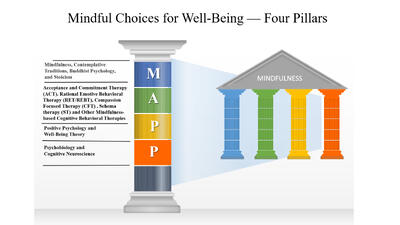 Our work is based upon nearly forty years of clinical and personal experience and represents an integration of diverse approaches. While we have included applications from theoretical approaches, such as object relations, social learning theory, cognitive behavioral strategies, interpersonal or systems theory, and systems thinking, there is a primary emphasis on the following Four Pillars:
Our work is based upon nearly forty years of clinical and personal experience and represents an integration of diverse approaches. While we have included applications from theoretical approaches, such as object relations, social learning theory, cognitive behavioral strategies, interpersonal or systems theory, and systems thinking, there is a primary emphasis on the following Four Pillars:
1. Mindfulness, contemplative practices, Buddhist psychology, Stoicism.
2. Mindfulness and acceptance-based behavioral therapies, such as Acceptance and Commitment tTerapy (ACT), Dialectical Behavior Therapy (DBT), Mindfulness-based stress reduction (MBSR), and mindfulness-based cognitive therapy (MBCT). A significant part of this book is inspired by ACT, and we will therefore focus most attention on acceptance and commitment therapy. We also draw heavily upon rational emotive behavioral therapy (REBT), utilizing the earlier form rational emotive therapy (RET). We also draw upon compassion focused therapy (CFT) and Schema Therapy (ST).
3. Positive psychology and the science of happiness and well-being.
4. Neuroscience and brain-based change strategies, psychobiology, mind-body medicine, and cognitive neuroscience.
Although we have been open to whatever is useful and evidence-based from a wide variety of sources, we have worked to make sure that there is nothing inconsistent or contradictory within our work. For example, wherever we have utilized cognitive strategies, we have made sure that they are consistent with our focus on developing the qualities of moment-to-moment, non-judgmental mindful awareness and acceptance of internal experience, rather than a reliance on distraction, symptom management, development of competing behaviors, or avoidance. We emphasize one such approach, acceptance and commitment therapy, the most useful strategy we have found for moving from mindful awareness of present choices to values-driven choices.
Similarly, we have incorporated major findings from the relatively new field of positive psychology, and with amazing compatibility, we draw upon 2,500 years of wisdom in the application of the practice of mindfulness to all aspects of human existence. Neuroscience completes the picture with new understanding of how our brains work, an understanding leading to powerful insights for overcoming our built-in negativity bias while cultivating greater happiness and well-being in our lives. Most intriguing, recent brain research powerfully demonstrates the validity of ancient teachings on mindfulness and acceptance. Thus, neuroscience is a bridge connecting ancient wisdom with cognitive behavioral therapies via high-tech twenty-first-century science. Increasingly, an understanding of neuroscience has led to extremely useful evidence-based behavior change strategies that work through actual changes in brain function.
These four perspectives are interrelated when it comes to goal setting, focusing on psychological strengths, utilizing mindfulness skills, and clarifying values and meaning in life.
Let’s take a brief look at each of the Four Pillars.
1. Mindfulness, contemplative practices, Buddhist psychology, Stoicism.
Mindfulness is present-moment awareness, or conscious awareness of all that is happening in the here and now. It’s having an open and receptive attitude without judgment. It’s having an attitude of curiosity and a willingness to turn toward one’s experience rather than away from it.
Mindfulness is nothing less than a way of living your life with alertness and presence. It’s a process of awareness rather than thinking. It’s about paying attention to your experience in the present moment rather than being captivated by your thoughts. It’s about being fully present in the “here and now” rather than ruminating about the past or worrying about the future. It involves an attitude of openness and curiosity, no matter how difficult or painful your experience may be, rather than running from your experience or doing battle with it. It involves flexibility of attention with the ability to direct your focus to particular aspects of your experience.
Contemplative practices can be difficult to describe, as there is no single contemplative practice. Basically, these practices involve moment-by-moment awareness and deepening concentration, understanding, and insight. They involve disciplined attention that is even more essential in our highly stressed society, a society characterized by fragmentation, multitasking, information overload, ever-increasing speed, and ceaseless distractions.
Many of these practices are discussed in this book, and we will provide you with resources for pursuing specific practices further. These practices include, but are by no means limited to, various forms of meditation, visualization, journaling, yoga, Qigong, Tai chi, attentive listening, music, and dance.
Buddhist psychology is a nonreligious source of great ideas for well-being. Throughout the book we will draw upon Buddhist ideas, such as the practice of mindfulness, compassion for self and others, acceptance, practicing loving kindness, and dealing with emotional pain realistically without making it worse.
Stoicism, the basis for all cognitive behavioral therapies, had its beginnings in ancient Greece and grew to maturity in Rome. While the current meaning of “stoic” refers to someone who is uncomplaining and rather passive, the real meaning of stoicism has more to do with being tough-minded and resilient in the face of difficulties. Historical Stoics, such as Epictetus, Seneca, and Marcus Aurelius, saw pursuing reason as a pathway to a virtuous life and tranquility. Decades ago, Bill’s mentor, Albert Ellis, brought renewed interest in Stoicism to psychology. In Chapter 9, you will be introduced to Rational Emotive Therapy, a primary tool for becoming mindful of ways we disturb ourselves.
2. Mindfulness and acceptance-based behavioral therapies such as Acceptance and Commitment Therapy (ACT) and Rational Emotive Behavioral Therapy (REBT), or RET in it’s earlier form. Also, Compassion focused therapy (CFT) and Schema Therapy (ST)
Mindfulness is central to psychotherapeutic modalities such as Acceptance and Commitment Therapy (ACT), Dialectical Behavior Therapy (DBT), Mindfulness-based Stress Reduction (MBSR) and Mindfulness-based Cognitive Therapy (MBCT). Mindfulness is also embraced by practitioners of positive psychology who see mindfulness as a foundation for facilitating a number of healthy skills and behaviors, therefore making it more likely that those choices will be exercised in decreasing negative mood, enhancing positive mood, or enhancing positive feelings and thoughts about yourself and your relation to your world and your future.
Although there are several approaches in this category, here we will focus specifically on Acceptance and Commitment Therapy (ACT). ACT is a radical departure from traditional Western psychotherapy practices. It is mindfulness-based and values-oriented and draws much from non-religious Buddhist psychology. Drawing upon the Buddhist notion that human suffering is inevitable, ACT similarly sees difficult thoughts and feelings as an inevitable part of the human condition, and not something that must be gotten rid of. Attempts to avoid pain often magnify it rather than eliminate it.
The name ACT stems from “acceptance” of what is outside your personal control and “commitment” to values-based choices for enriching life. According to Joseph Ciarrochi, Todd B Kashdan, and Russ Harris in their article, “The Foundations of Flourishing”:
The aim of ACT is, quite simply, to maximize human potential for a rich, full, and meaningful life. ACT (which is pronounced as the word “ACT,” not as the initials A.C.T.) Does this by a) teaching you mindfulness skills to deal with your painful thoughts and feelings effectively – in such a way that they have much less impact and influence over you; and b) helping you to clarify your core values, and use that knowledge to guide, inspire, and motivate comitted action.”
Based on Stoicism, Rational Emotive Behavioral Therapy (REBT) is based on the idea that we disturb ourselves by things we have learned to tell ourselves. We use an earlier version of REBT created in the late 1950s by Albert Ellis. Rational emotive therapy or RET is a remarkably easy process for discovering your specific irrational beliefs. As such, it’s a great mindfulness tool as you soon find yourself being more conscious of your negative self-talk and dysfunctional beliefs. Once fully aware, acceptance and commitment therapy provides a quick and effective way to simply notice irrational beliefs, determine whether they are useful or helpful, and choose to continue on, guided by your goals and values.
Compassion focused therapy integrates science-based approaches with mind-training practices dating back thousands of years. CFT’s foundation is in evolutionary psychology, affective neuroscience, attachment theory, behaviorism, and cognitive behavioral therapy. CFT is particularly helpful in overcoming shame and self-criticism. In the words of Russell L Kolts, PhD, author of CFT Made Simple: A Clinician’s Guide to Practicing Compassion-Focused Therapy:
Compassion gives us a way to turn toward the things that scare us—with kindness, wisdom, and courage—and to work with them. When we stop trying to avoid discomfort, we can turn toward suffering and look deeply into it, so we can come to understand the causes and conditions that create it—perhaps even learning enough to help make things better.
Developed originally by Jeffrey Young and others in 1990, Schema Therapy is a rather recent development in psychotherapy. In this book we will make reference to schemas and modes.
Schemas are about the ways we see ourselves, others, and our world. You might think of schemas as clusters of thoughts, feelings and behaviors that usually originate when core needs are not fully met in childhood or adolescence. They begin as early patterns of coping or making sense of things and then become etched into our memory through difficult early experiences. They operate like an unseen computer program playing in the background, waiting to be triggered by current stressors. However while they might have served a purpose during childhood, they are maladaptive and rather mindless ways of responding as adults and account for why we keep doing the same things over and over again even though our actions are often self-defeating or dysfunctional.
While schemas can be thought of as personality traits, schema modes are "states." Modes are combinations of behaviors and schemas and can be either adaptive or maladaptive. They can be very brief or long-term, and can rapidly change.
An understanding of your schemas and modes can be immensely powerful in shaping positive choices and powerful positive habits.
3. Positive psychology and the science of happiness and well-being.
The aim of positive psychology is to make available all that has been learned about healthy living and well-being. Like ACT, the aim of positive psychology is the promotion of human flourishing. A major working assumption of positive psychology is that thriving is not simply getting rid of the negative aspects of life, and that there are choices for promoting healthy living and well-being.
4. Neuroscience and brain-based change strategies, psychobiology, mind-body medicine and cognitive neuroscience.
A relatively new term in scientific vocabulary is “neuroplasticity.” We now know that you can use your mind to actually bring about structural changes in your brain. According to Daniel J Siegel, author of The Mindful Brain, neurons that fire together wire together. In other words, “repeated firing of neurons in specific areas would result in markedly increased synaptic densities in those regions that were activated with mindful practice.” Siegel goes on to state that “Mindful awareness is a form of experience that seems to promote neuroplasticity.” Purposely paying attention to the present moment seems to stimulate the brain to promote growth in specific brain regions associated with the creation of well-being.
Much of our work builds upon what brain research says about developing habits. You are constantly creating habits, good ones and bad ones, and you create them for a reason. Your brain, literally the most complex thing in the universe, uses about 20 percent of total body energy. Still, despite this enormous energy supply, your brain would quickly be overwhelmed if it had to deal with the incredible flow of information coming at you each second. Consider, for example, driving your car. If you were conscious of each and every detail, you’d have to focus on thousands of pieces of information and make thousands of decisions. You probably wouldn’t get very far. Your brain’s solution is the creation of habits. Anything you do more than once is on its way to becoming a habit, thus freeing up your brain to tackle more complex situations. Throughout this book, we will be guiding you step by step in the transformation of basic mindful choices into powerful and enduring habits for well-being.
In short, brain research has led to an understanding of how to rewire your brain, freeing you from destructive ways of thinking and behaving, while building on choices that utilize your values and strengths, choices that lead to resilience and well-being, or “thriving.” We will be discussing how you can use specific brain-based practices, such as memory reconsolidation or coherence therapy, and other strategies, such as mental contrasting, intention implementation, and visualization meditation.
This has been a brief introduction to our “Four Pillars.” More will follow throughout the book.
You have begun an important journey, and one that will be transformational. We begin in Chapter 1 with a short story illustrating the power of “Mindful Choices.”
Enjoy your journey. Carpe diem!
.jpg&w=400&h=400)






